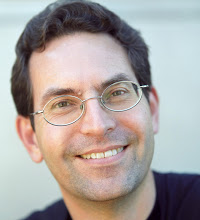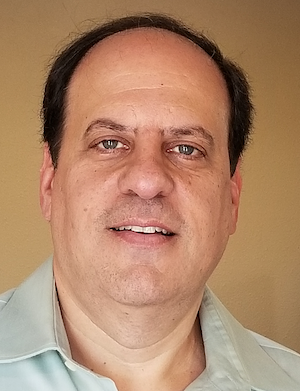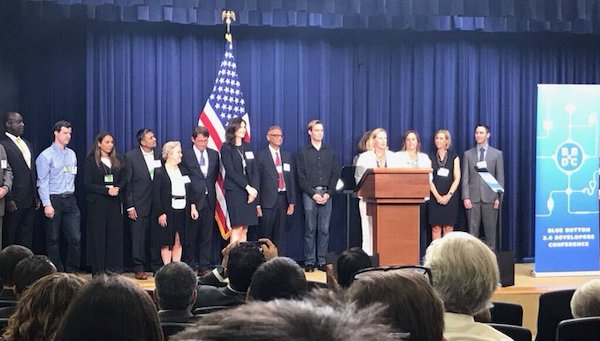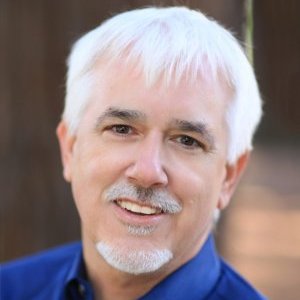 As I wrote last week, I expected 2017 HIMSS to be filled with Wearables, Big Data, Social Networking concepts from other industries, Telemedicine, and Artificial Intelligence. I was not disappointed. 42,000 of my closest friends each walked an average of 5 miles per day through the Orlando Convention Center. One journalist told me “It’s overwhelming. You do your best to look professional and wear comfy shoes!” After 50 meetings, and 12 meals in 3 days, here’s my impression of the experience...
As I wrote last week, I expected 2017 HIMSS to be filled with Wearables, Big Data, Social Networking concepts from other industries, Telemedicine, and Artificial Intelligence. I was not disappointed. 42,000 of my closest friends each walked an average of 5 miles per day through the Orlando Convention Center. One journalist told me “It’s overwhelming. You do your best to look professional and wear comfy shoes!” After 50 meetings, and 12 meals in 3 days, here’s my impression of the experience...
Fast Healthcare Interoperability Resources (FHIR)
See the following -
Cerner to Highlight Commitment to Interoperability at HIMSS15
Cerner Corp. will showcase its commitment to advancing health care interoperability across organizational, supplier and geographic boundaries at HIMSS15, April 12-16, at McCormick Place in Chicago. "Cerner has long been committed to connecting organizations and systems, regardless of platform or provider, to ensure the free flow of data across the continuum of care," said Zane Burke, president, Cerner. "Across multiple HIMSS engagements, we look forward to sharing our story of connected health care and the importance of true, industry-wide interoperability."
- Login to post comments
CHIME, HL7 Applaud ONC Road Map, JASON Task Force Recommendations
Health industry groups expressed optimism following the Oct. 15 meeting of the federal government's Health IT Policy and Standards committees to discuss a draft interoperability road map unveiled by the Office of the National Coordinator for Health IT. In particular, the College of Healthcare Information Management Executives and Health Level Seven International (HL7) viewed the road map as a step in the right direction...
- Login to post comments
Clinical Decision Support Strategies for Electronic Case Reporting and its Open Source Connection
 A key element of public health surveillance is the reporting of infectious and certain non-infectious conditions to state, local, and tribal public health agencies (PHA) around the United States. Historically, there have been a number of key challenges with the process of case reporting that is pervasive in the United States today. To help overcome some of these barriers, an effort has been underway to move the process of case reporting to electronic. A key component of the emerging electronic care reporting (eCR) strategy is the use of clinical decision support (CDS) to help clinical care organizations determine if a reportable condition is present in a patient's record. Multiple approaches have been identified for this CDS service, including a centralized model being implemented today, and several distributed options which will likely become equally viable. Given the size, diversity, and decentralized nature of healthcare enterprises, it is likely that all three approaches for CDS discussed in this article will be deployed simultaneously.
A key element of public health surveillance is the reporting of infectious and certain non-infectious conditions to state, local, and tribal public health agencies (PHA) around the United States. Historically, there have been a number of key challenges with the process of case reporting that is pervasive in the United States today. To help overcome some of these barriers, an effort has been underway to move the process of case reporting to electronic. A key component of the emerging electronic care reporting (eCR) strategy is the use of clinical decision support (CDS) to help clinical care organizations determine if a reportable condition is present in a patient's record. Multiple approaches have been identified for this CDS service, including a centralized model being implemented today, and several distributed options which will likely become equally viable. Given the size, diversity, and decentralized nature of healthcare enterprises, it is likely that all three approaches for CDS discussed in this article will be deployed simultaneously.
- Login to post comments
Cloud Providers Reaffirm Commitment to Open Healthcare Interoperability During 2019 Blue Button Developers Conference
 As healthcare evolves across the globe, so does our ability to improve the health and wellness of communities. Patients, providers, and health plans are striving for more value-based care, more engaging user experiences, and broader application of machine learning to assist clinicians in diagnosis and patient care. Too often, however, patient data are inconsistently formatted, incomplete, unavailable, or missing - which can limit access to the best possible care. Equipping patients and caregivers with information and insights derived from raw data has the potential to yield significantly better outcomes. But without a robust network of clinical information, even the best people and technology may not reach their potential...
As healthcare evolves across the globe, so does our ability to improve the health and wellness of communities. Patients, providers, and health plans are striving for more value-based care, more engaging user experiences, and broader application of machine learning to assist clinicians in diagnosis and patient care. Too often, however, patient data are inconsistently formatted, incomplete, unavailable, or missing - which can limit access to the best possible care. Equipping patients and caregivers with information and insights derived from raw data has the potential to yield significantly better outcomes. But without a robust network of clinical information, even the best people and technology may not reach their potential...
- Login to post comments
CommonWell: Healthcare Interoperability Or Bust
Peter Bernhardt of CommonWell Health Alliance, a group of clinical and health IT organizations, talks about its goal of better data exchange and application integration...
- Login to post comments
Composable Software, Collaborative Development, and the CareWeb Framework
The CareWeb Framework (CWF) enables the software developer to build complex, richly interactive, web-based applications in a modular fashion...The CWF has been used as the basis for a complete EHR and CPOE system and has been ported to several open source EHRs, including OpenMRS, VistA, and RPMS. The CWF is open source software built upon open source software. Read More »
- Login to post comments
Distributed Ledgers, the Next step in Patient Generated Health Data (PGHD) Including Environmental Data
 Soon we will be able to access thousands of datapoint into our lives, many will reflect our environment and health. The HHS Idea Labs held a Entrepreneur-in-Residence webinar on December 13, 2016, for recruiting an software architect to assist the National Institute for Occupational Safety and Health (NIOSH) in collecting employment data as it pertains to a persons health. They wish to share/store the collected data in the EHR. Onerous at best, because most EHR today do not have API for uploading data and HL7 standards do not currently provide for discreet PGHD data...
Soon we will be able to access thousands of datapoint into our lives, many will reflect our environment and health. The HHS Idea Labs held a Entrepreneur-in-Residence webinar on December 13, 2016, for recruiting an software architect to assist the National Institute for Occupational Safety and Health (NIOSH) in collecting employment data as it pertains to a persons health. They wish to share/store the collected data in the EHR. Onerous at best, because most EHR today do not have API for uploading data and HL7 standards do not currently provide for discreet PGHD data...
- Login to post comments
Epic and Other EHR Vendors Caught in Dilemmas by APIs (Part 1 of 2)
The HITECH act of 2009 (part of the American Recovery and Reinvestment Act) gave an unprecedented boost to an obscure corner of the IT industry that produced electronic health records. For the next eight years they were given the opportunity to bring health care into the 21st century and implement common-sense reforms in data sharing and analytics. They largely squandered this opportunity, amassing hundreds of millions of dollars while watching health care costs ascend into the stratosphere, and preening themselves over modest improvements in their poorly functioning systems...
- Login to post comments
Epic and Other EHR Vendors Caught in Dilemmas by APIs (Part 2 of 2)
The first section of this article reported some news about Epic’s Orchard, a new attempt to provide an “app store” for health care. In this section we look over the role of APIs as seen by EHR vendors such as Epic. Dr. Travis Good, with whom I spoke for this article, pointed out that EHRs glom together two distinct functions: a canonical, trusted store for patient data and an interface that becomes a key part of the clinician workflow. They are being challenged in both these areas, for different reasons...
- Login to post comments
Geisinger, xG Health Solutions™ to Advance Open Health Care Application Ecosystem
Geisinger Health System and xG Health Solutions announced today they have connected a software app developed by Geisinger to an Electronic Health Record (EHR) by leveraging new draft international standards...[using] an approach developed with support from...[the] Office of the National Coordinator's Strategic Healthcare IT Advanced Research Projects (SHARPn) grant, specifically the open-source Substitutable Medical Apps, Reusable Technologies (SMArt) Platform...
- Login to post comments
Grahame Grieve on What Project Argonaut Means for the HL7/FHIR Community
Project Argonaut was announced last week. You can see the announcement here. That press release was intended for an external community, and didn’t address lots of important questions for the HL7 community itself. So here’s an outline of what project Argonaut means in practice for HL7.
- Login to post comments
Halamka Reports on the Progress on Interoperability Made by the HIT Standards Committee
 The March 2015 HIT Standards Committee was one of the most impactful meetings we have ever had. No, it was not the release of Meaningful Use Stage 3 or the certification rule. It was the creation of a framework that will guide all of our work for the next several years - everything we need for a re-charted standards harmonization convening body as well as a detailed interoperability roadmap, complementing the 10 year general plan developed by ONC. Thanks to Arien Malec for yeoman’s work in both areas...
The March 2015 HIT Standards Committee was one of the most impactful meetings we have ever had. No, it was not the release of Meaningful Use Stage 3 or the certification rule. It was the creation of a framework that will guide all of our work for the next several years - everything we need for a re-charted standards harmonization convening body as well as a detailed interoperability roadmap, complementing the 10 year general plan developed by ONC. Thanks to Arien Malec for yeoman’s work in both areas...
- Login to post comments
Halamka Says We Can and Must Improve Healthcare Management
 As a physician and CIO, I’m quick to spot inefficiencies in healthcare workflow. More importantly, as the care navigator for my family, I have extensive firsthand experience with patient facing processes. My wife’s cancer treatment, my father’s end of life care, and my own recent primary hypertension diagnosis taught me how we can do better. Last week, when my wife received a rejection in coverage letter from Harvard Pilgrim/Caremark, it highlighted the imperative we have to improve care management workflow in the US. Since completing her estrogen positive, progesterone positive, HER2 negative breast cancer treatment in 2012 (chemotherapy, surgery, radiation), she’s been maintained on depot lupron and tamoxifen to suppress estrogen...
As a physician and CIO, I’m quick to spot inefficiencies in healthcare workflow. More importantly, as the care navigator for my family, I have extensive firsthand experience with patient facing processes. My wife’s cancer treatment, my father’s end of life care, and my own recent primary hypertension diagnosis taught me how we can do better. Last week, when my wife received a rejection in coverage letter from Harvard Pilgrim/Caremark, it highlighted the imperative we have to improve care management workflow in the US. Since completing her estrogen positive, progesterone positive, HER2 negative breast cancer treatment in 2012 (chemotherapy, surgery, radiation), she’s been maintained on depot lupron and tamoxifen to suppress estrogen...
- Login to post comments
Halamka's 2016 Predictions for Health IT
 As the year ends and we archive the accomplishments and challenges of 2015, it’s time to think about the year ahead. Will innovative products and services be social, mobile, analytics, and cloud (SMAC)? Will wearables take off? Will clinicians be replaced by Watson? Here are my predictions...Apps will layer on top of transactional systems empowered by FHIR...a better approach is crowdsourcing among clinicians that will result in value-added apps that connect to underlying EHRs via the protocols suggested in the Argonaut Project (FHIR/OAuth/REST). One of our clinicians has already authored a vendor neutral DICOM viewer for images, a patient controlled telehealth app for connecting home devices, and a secure clinical photography upload that bypasses the iPhone camera roll. That’s the future.
As the year ends and we archive the accomplishments and challenges of 2015, it’s time to think about the year ahead. Will innovative products and services be social, mobile, analytics, and cloud (SMAC)? Will wearables take off? Will clinicians be replaced by Watson? Here are my predictions...Apps will layer on top of transactional systems empowered by FHIR...a better approach is crowdsourcing among clinicians that will result in value-added apps that connect to underlying EHRs via the protocols suggested in the Argonaut Project (FHIR/OAuth/REST). One of our clinicians has already authored a vendor neutral DICOM viewer for images, a patient controlled telehealth app for connecting home devices, and a secure clinical photography upload that bypasses the iPhone camera roll. That’s the future.
- Login to post comments
Halamka's Dispatch from HIMSS 2017
- Login to post comments